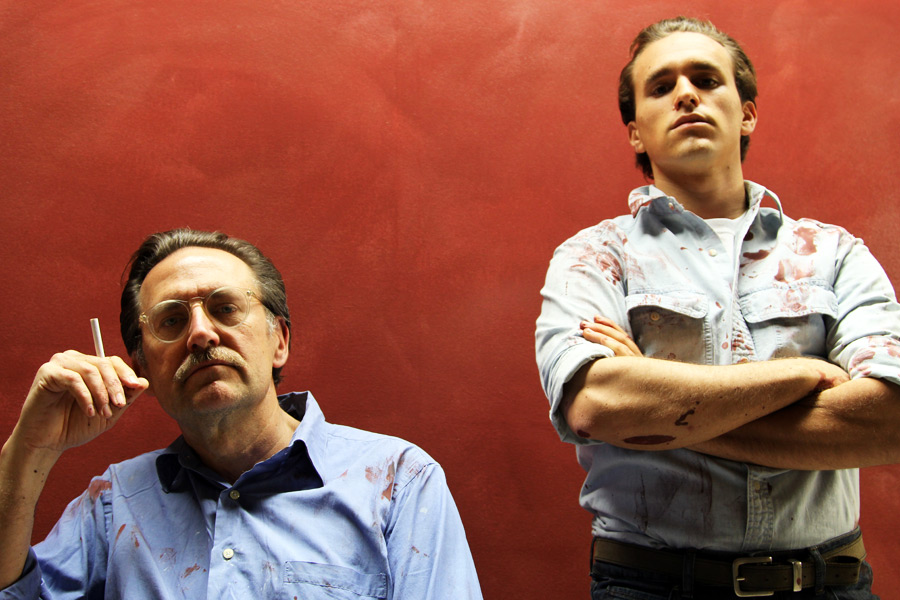RED Leaves Audience with Much to Consider at Guild Hall

What is the difference between true, contemplative, moving art and decoration? Must there be a distinction? Does it matter?
These are the questions posed in RED, John Logan’s Tony Award-winning and endlessly quotable play, running through June 8 at Guild Hall’s John Drew Theater in East Hampton.
The production, directed by Stephen Hamilton, is a fictionalized account of true events, recounting the story of abstract painter Mark Rothko’s 1958 commission to paint a series of murals for the new (at the time) Four Seasons Restaurant inside the Seagram Building in Manhattan. And the conflict—the question, the irony and absurdity—comes into sharp focus as the famous painter (played by Victor Slezak) meets his young assistant Ken (Christian Scheider) in RED’s opening scene.
Rothko rants to Ken about the gravity and significance of his paintings, and of painting in general. “These pictures deserve compassion and they live or die in the eye of the sensitive viewer,” he says, then admonishes Ken for saying he “likes” his paintings. “Where’s the discernment?” Rothko asks, continuing to quiz his new assistant about art’s greater place in the world, in philosophy, theology, literature, poetry, drama, history and so on… Until they agree the works are disquieting, thoughtful, sad and, perhaps above all, tragic.
“They’re for a restaurant,” Rothko announces with flawless comic/ironic timing—setting the stage for the two-year discussion that follows in five scenes.
The paintings were, in fact, the largest modern art commission at the time, and one that Rothko never delivered. In the end, after two years and some 30 paintings (though Seagram only had room for seven) he gave back the $35,000 fee (which was like $2 million today). RED attempts to explain how the painter chose the integrity of his work over a massive payday.
Throughout the play, chatter between Rothko and Ken touches on the panoply of art topics—mostly turning back to the master’s work, its purpose and place. Rothko first imagines his murals surrounding the Four Seasons’ interior as a “continuous narrative, filling the walls…the story unfolding…inescapable and inexorable, like doom.” But his delusion slowly unravels, with a little help from Ken.
The paintings they create mostly hang the mind’s eye, just beyond the stage’s fourth wall (though some clever set pieces also show the progress of two works). And thanks to Hamilton’s decision to put the audience onstage with the actors and simple set, a feeling of shared experience and intimacy exists that wouldn’t happen with more standard theater seating.
As these men take a winding course toward their truth, the audience is right alongside them, feeling all the pain and inspiration, made deliciously palpable by Slezak and Scheider.
With no sense of irony, Rothko laments those artists who become superfluous in their own lifetime, the pain of becoming a commodity, and the “overmantles”— works doomed to become decoration and hang over the fireplace. He talks of destroying the artists who came before him, pointing out that Cubism died at the hands of the Abstract Expressionists. “The child must banish the father. Respect him, but kill him,” he says.
But later, painfully unaware of his position, Rothko bashes the work of the growing Pop Art movement and its painters’ lack of seriousness. This, finally, pushes Ken over the edge and he lays Rothko—and all his pomp, hypocrisy and egotism—bare, while also earning his respect for the first time. “The High Priest of Modern Art is painting a wall in the Temple of Consumption,” he says. “You rail against commercialism in art, but pal, you’re taking the money.”
By the end of RED, both Rothko and Ken have learned from one another and from the commission. More importantly, the audience is left with a great deal to chew on and consider—and its impact is no small thing, no matter what one takes away.
RED is playing at Guild Hall’s John Drew Theater Wednesdays–Sundays at 8 p.m. through June 8. Due to the intimate nature of the staging (with the audience seated onstage) seating is limited and general admission tickets should be purchased in advance.
The John Drew Theater is located at Guild Hall (158 Main Street) in East Hampton. Call 631-324-0806 or visit guildhall.org for tickets and info.




